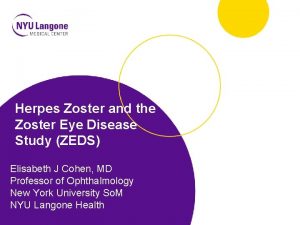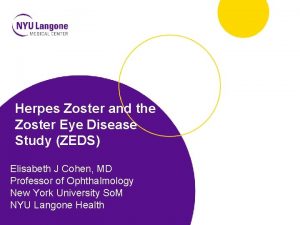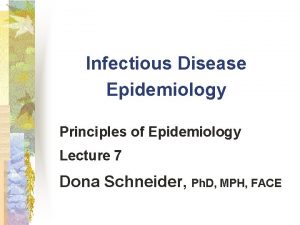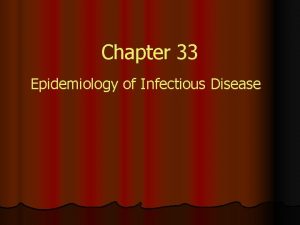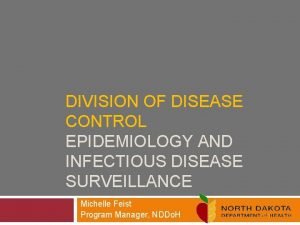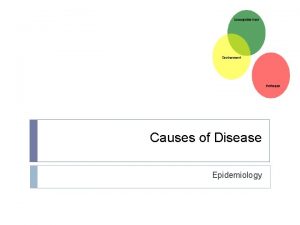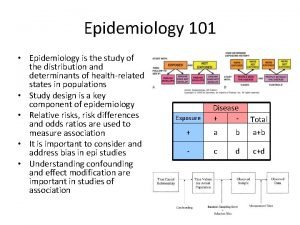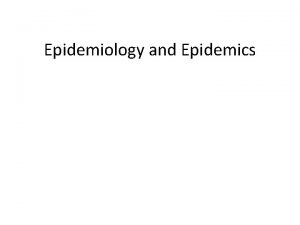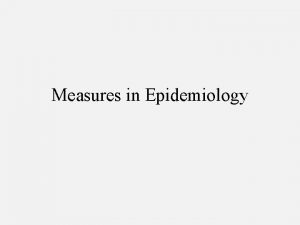Epidemiology The Study of Disease in Populations Epidemiology






















- Slides: 22

Epidemiology The Study of Disease in Populations

Epidemiology • • • Terminology Disease Reservoirs Acquisition and transmission Nosocomial infections Case study: epidemiology of AIDS

Communicable Disease Patterns

Frequency statistics Total number of cases in population X 100 Prevalence = Total number of ________ in population Incidence = Number of new cases Number of _________ persons in population Example: 100 people, 10 new people with disease --> prevalence of 10/100 = 10% --> incidence of 10/90 = 1/9 10 new people get disease --> prevalence of 20/100 = 20% --> incidence of 10/80 = 1/8

Morbidity and mortality Morbidity -- Incidence of a disease in a population, including both fatal and nonfatal cases Mortality -- Incidence of ________ in a population

Disease Reservoirs Reservoir -- site in which viable infectious agents remain ________ and from which infection of individuals may occur Animals (“Zoonosis” -- a disease which occurs primarily in animals but which can be transmitted to humans): rabies, bovine tuberculosis, malaria, etc. Human carriers Source -- actual person or object from which an infection comes

Human carriers: individuals who inconspicuously harbor a pathogen Asymptomatic carriers -- infected, but with no ________ manifest Can be because the disease is within an incubation period (“acute carriers”) or because individuals have either recovered from an infection or because they have a subclinical infection which has remained non-apparent (“chronic carriers”) Passive carriers -- not ___________; infections passed on hands, instruments, etc.

Typhoid Mary: classic asymptomatic chronic carrier

Acquisition and transmission Diseases can be communicable or noncommunicable Epidemiologists search for a pattern of ___________ which may indicate the mode of transmission

Incidence of viral meningitis in the U. S. Note marked summer rise and _________ nature of occurrence

Transmission Direct host-to-host: cold & flu, STDs, skin pathogens Indirect host-to-host: spread via vectors (living agents) or fomites (________ objects)


The shape of an epidemic curve helps to distinguish the likely _______

DNA Fingerprinting to Determine Possible Origins of Outbreaks New York's Lethal Virus Came From Middle East, DNA Suggests FORT COLLINS, COLORADO--A group of public health researchers announced at a workshop held here last week that the DNA sequence of the virus that caused an epidemic of brain inflammation in and around New York City this summer conclusively shows that it is the West Nile virus--an identification that was under debate until recently. They also reported that the virus's genome is almost identical to that of a West Nile strain found in Israel last year, suggesting that it originated in the Middle East. Many now agree it has a good chance of establishing itself and spreading in the Western Hemisphere. Science 286: 1450 -1451. Nov. 19, 1999

DNA Fingerprinting of Pathogenic Bacteria FIG. 1. REP-PCR fingerprints of food isolates of Listeria monocytogenes. Note the banding similarity in the fingerprints in lanes 5356 and 59 -63, illustrating how identical or nearly identical strains of a pathogen like Listeria can be identified and tracked with great specificity. Lane M contains molecular size markers. B. Jersek et al. 1999. Typing of Listeria monocytogenes Strains by Repetitive Element Sequence-Based PCR. J. Clin. Microbiol. 37: 103 -109.

Coevolution of host and parasite: Australian rabbits and the myxoma virus

Nosocomial infections -- major sites

Epidemiology of AIDS

Epidemiology of AIDS: AIDS in men, 1993

Epidemiology of AIDS: AIDS in women, 1993

Global Health Considerations Leading causes of death in developed countries

Leading causes of death in developing countries
 What is descriptive study in epidemiology
What is descriptive study in epidemiology Communicable disease and non communicable disease
Communicable disease and non communicable disease Jewish chronic disease hospital study pdf
Jewish chronic disease hospital study pdf Celiac disease pes statement
Celiac disease pes statement Zoster eye disease study
Zoster eye disease study Zoster eye disease study
Zoster eye disease study Hát kết hợp bộ gõ cơ thể
Hát kết hợp bộ gõ cơ thể Frameset trong html5
Frameset trong html5 Bổ thể
Bổ thể Tỉ lệ cơ thể trẻ em
Tỉ lệ cơ thể trẻ em Chó sói
Chó sói Glasgow thang điểm
Glasgow thang điểm Bài hát chúa yêu trần thế alleluia
Bài hát chúa yêu trần thế alleluia Kể tên các môn thể thao
Kể tên các môn thể thao Thế nào là hệ số cao nhất
Thế nào là hệ số cao nhất Các châu lục và đại dương trên thế giới
Các châu lục và đại dương trên thế giới Công thức tính thế năng
Công thức tính thế năng Trời xanh đây là của chúng ta thể thơ
Trời xanh đây là của chúng ta thể thơ Mật thư tọa độ 5x5
Mật thư tọa độ 5x5 Làm thế nào để 102-1=99
Làm thế nào để 102-1=99 độ dài liên kết
độ dài liên kết Các châu lục và đại dương trên thế giới
Các châu lục và đại dương trên thế giới Thể thơ truyền thống
Thể thơ truyền thống




